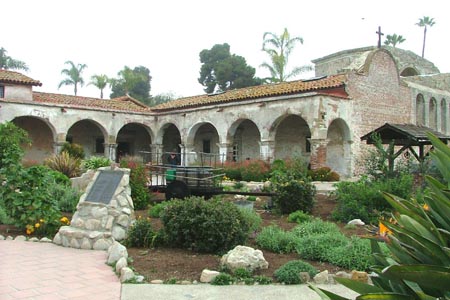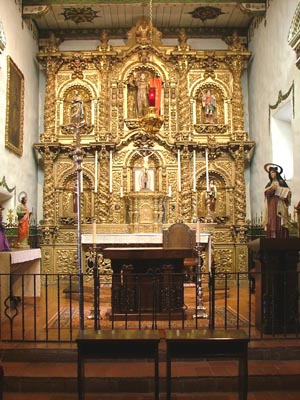| |
 |
 |
 |
| Comment on this report, or find other reports. |
 |
| Our Mystery Worshippers are volunteers who warm church pews for us around the world. If you'd like to become a Mystery Worshipper, start here. |
 |
| Find out how to reproduce this report in your church magazine or website. |
|
|
| 1688: The Mission,
San Juan Capistrano, California, USA |
 |
 |
 |
Mystery Worshipper:
Amanda B. Reckondwythe.
The church:
The Mission,
San Juan Capistrano, California, USA.
Denomination:
Roman Catholic, Diocese
of Orange.
The building:
The mission at San Juan Capistrano was one of over a dozen missions
established between 1769 and 1784 by Padre Junípero Serra, a
middle-aged, asthmatic Franciscan priest, in the Spanish New
World colony of California along the road known as El Camino
Real. Dubbed "the jewel of the missions" due to its
elaborate structures and successful ministries, the Capistrano
mission was, however, severely damaged in 1812 by an earthquake
and was not rebuilt. Mexico declared its independence from Spain
in 1821 and secularized all of the California missions, including
the still-in-ruins Capistrano buildings. In 1848 Mexico ceded
California to the United States, and in 1865 President Abraham
Lincoln returned the Capistrano mission to the Catholic Church,
one of his last official acts before his assassination. Restoration,
however, did not begin until the turn of the 20th century. Many
of the buildings have now been restored as a tourist attraction,
and a new basilica in the Spanish style stands near Padre Junípero's
original chapel. Today, more than 60 percent of California's
residents live in areas surrounding the various mission sites,
and El Camino Real is a major highway running much of the length
of the state.
The church: The mission is inextricably linked with the phenomenon known as the miracle of the swallows of Capistrano. In the period following the 1812 earthquake, people began to notice that cliff swallows, which had been attracted to the area for centuries by the abundance of insects on which they feed, would return to the mission each year on or around March 19, St Joseph's Day, to build their nests among its ruins. Legend has it that the swallows winter in the Holy Land and return bearing an olive twig in their beaks, which they drop on the ocean when they want to rest from their journey. However, ornithologists have traced their winter habitat to Argentina. To this day, the swallows continue to return near St Joseph's Day each year, albeit in somewhat reduced numbers that no longer blacken the skies as they are said once to have done. The city celebrates the event with a series of festivals that transform the otherwise quiet community into a tourist mecca. The birds remain until October 23, the feast of St John of Capistrano, when they depart as suddenly as they arrived.
The neighborhood:
The city of San Juan Capistrano sits a few miles inland from
California's Pacific coast about halfway between Los Angeles
and San Diego. It is primarily residential in character, with
abundant open spaces and hillsides that give it a sleepy, tranquil
appearance. San Juan Capistrano is easily reached by train either
from Los Angeles or San Diego, and the delightful little railroad
station is in itself worth the trip. The mission is only a short
walk from the station.
The cast: The Revd Michael Pontarelli, OSM, priest in residence. Father Pontarelli was vested in a white chasuble with colorful Mexican themed orphreys and was assisted by a lay reader and two acolytes, a lady and a gentleman in albs.
The date & time: Feast of St Joseph, March 19, 2009, 7.00am. I was surprised at how difficult it was to discover mass times or any other information about religious (as opposed to secular) events planned for the day; I had finally to email the Basilica. Fortunately they were kind enough to reply.
What was the name of the service?
Mass.
How full was the building?
The building can hold about 150 and was about seven-eighths full. Mass was held in Padre Junípero's original chapel, a narrow building with red tiled floor, white plaster walls, a wood ceiling with colorfully painted beams, and an ornate gilt Spanish style reredos behind the altar.
Did anyone welcome you personally?
No.
Was your pew comfortable?
Yes. It was a plain wooden pew that creaked when you moved, but it was comfortable, with plenty of legroom.
How would you describe the pre-service
atmosphere?
Quiet except for the creaking pews.
What were the exact opening words of the
service?
"In the name of the Father, and of the Son, and of the Holy Spirit. Amen." Father then asked how many men in the congregation were named Joseph, and reminded us that Pope Benedict's Christian name was Joseph.
What books did the congregation use during the
service?
None. There were a few leftover copies of the previous Sunday's
bulletin, and the Catholic Community Hymnal was in
the pews, but nothing was sung except as noted below.
What musical instruments were played?
None.

Did anything distract you?
I was expecting a congregation primarily of tourists, but it appeared that most of the people there were regulars. They seemed to expect the few little irregularities that were sprinkled into the mass here and there, and took them very much in stride.
Was the worship stiff-upper-lip,
happy clappy, or what?
A well celebrated novus ordo low mass. It was refreshing
to have no hymns (except as will be noted) – i.e., not to have
to sit through those horrid ditties that pass for hymnody in
so many Catholic churches. The sanctuary bell was rung as the
altar party entered, but there were no bells at the sanctus
or the consecration. We received communion under both species.
Everyone chanted the Agnus Dei in Latin to a Gregorian setting,
and we sang "Holy God, we praise thy name" after the dismissal;
otherwise there was no singing. Mass concluded with the Leonine
prayers (yes!).
Exactly how long was the
sermon?
5 minutes.
On a scale of 1-10, how good was the preacher?
9 – Father Pontarelli's accent was a little hard to understand, but he spoke intimately and personally, as if he were addressing each one of us individually in conversation.
In a nutshell, what was the sermon
about?
St Joseph is the patron saint of the universal Church, and March is the month of St Joseph. He was not the father of Jesus, but rather his guardian, and as such he submitted his will and his intellect to God. He set an example for all of us. According to tradition, St Joseph died in the arms of Jesus and Mary, and so he is also the patron saint of a happy death. The devil works overtime to steal one's soul at the hour of death, and so we would do well to place our trust in St Joseph.
Which part of the service was like being in
heaven?
It was heavenly to think that we were attending mass in the very chapel where Padre Junípero celebrated mass for his flock.
And which part was like being in... er... the other place?
No publicity, no greeting, no bulletin, no after-service handshakes – no way to start off a festive occasion on a religious note, in my opinion. But it got worse – read on!
What happened when you hung around after the service looking lost?
Nothing. The altar party retired to the sacristy and did not emerge to greet the congregation. As we were leaving, a gentleman asked us where we were from and said he hoped we would have an enjoyable day, but that was it.
How would you describe the after-service
coffee?
We walked over to Sarducci's Restaurant, in the train station, for a delicious breakfast, and after that returned to the mission for the festivities that had been scheduled. The day had started off cold and dreary, with a thick damp fog rolling in from the Pacific Ocean as is so common in southern California this time of year. But promptly at 10.00, the sun was able to pierce through the fog and the historic mission bells were rung. But, alas, no swallows! Not a one! What birds we did see appeared to be crows. A stage had been set up in the mission courtyard on which groups of school children in ethnic costumes did a series of Hispanic and Mexican dances – the sort of entertainment that only the families of the children could enjoy. By noon my party and I had had enough, and we took an early train home.
How would you feel about making this church your regular (where 10 = ecstatic, 0 = terminal)?
1 – What a disappointment! Not only did the organizers of the event seem to take special pains to separate the religious from the secular, but it seemed to us that they put on a poorly conceived, poorly planned show that held no one's attention. And where, oh where, were the swallows?
Did the service make you feel glad to be a
Christian?
Mass did, but the rest of the event did not.
What one thing will you remember about all this in seven days' time?
The day the swallows didn't return to Capistrano. |
|
|
 |
 |
 |
| We rely on voluntary donations to stay online. If you're a regular visitor to Ship of Fools, please consider supporting us. |
 |
 |
 |
| The Mystery Pilgrim |
 |
| One of our most seasoned reporters makes the Camino pilgrimage to Santiago de Compostela in Spain. Read here. |
 |
 |
 |
| London churches |
 |
| Read reports from 70 London churches, visited by a small army of Mystery Worshippers on one single Sunday. Read here. |
| |
|
|
|
|


